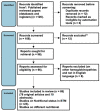Nutritional studies in patients with β-thalassemia major: A short review
- PMID: 37326258
- PMCID: PMC10308461
- DOI: 10.23750/abm.v94i3.14732
Nutritional studies in patients with β-thalassemia major: A short review
Abstract
Background: Patients with β-thalassemia major (BTM) had variable prevalence of undernutrition and abnormal body composition. Methods: We performed an electronic search in PubMed, Scopus, Research gate, and Web of Sciences to evaluate the prevalence of nutritional disorders in patients with BTM worldwide in relation to their body composition and possible etiological factors. In addition, we reviewed the published nutritional intervention studies. Results: 22 studies on the prevalence of undernutrition (12 countries) and 23 nutritional intervention studies were analyzed. Undernutrition occurred in a considerable number of patients but varied greatly among different countries (from 5.2% to 70%). The lower middle income (LMI) countries (India, Pakistan, Iran, Egypt) had higher prevalence, while (high -middle and high income (Turkey, Greece, North America, USA, Canada) had lower prevalence. Even in patients with normal BMI, abnormalities of body composition are common with decreased muscle mass, lean-body mass, and bone mineral density. 65% to 75% of them had lower energy intake with low levels of circulating nutrients, minerals (zinc, selenium, and copper), and vitamins (D, E) versus controls. Increased macro and micronutrient requirements decreased absorption and /or increased loss or excretion are etiologic factors. Undernutrition was associated with short stature and lower quality of life (QOL). High prevalence of endocrinopathies, poor transfusion regimen (tissue hypoxia), improper chelation, and lack of maternal education, represented important risk factors in the production of poor growth in weight and stature.
Conclusions: Timely detection of undernutrition in patients with BTM and proper nutritional intervention could prevent growth delay and comorbidities.
Conflict of interest statement
Each author declares that he or she has no commercial associations (e.g., consultancies, stock ownership, equity interest, patent/licensing arrangement etc.) that might pose a conflict of interest in connection with the submitted article.
Figures
References
-
- Fung EB. Nutritional deficiencies in patients with thalassemia. Ann N Y Acad Sci. 2010;1202:188–96. doi: 10.1111/j.1749-6632.2010.05578. x. - PubMed
-
- Fucharoen S, Ketvichit P, Pootrakul P, et al. Clinical manifestation of beta-thalassemia/hemoglobin E disease. J Pediatr Hematol Oncol. 2000;22(6):552–7. doi: 10.1097/00043426-200011000-00022. - PubMed
Publication types
MeSH terms
Substances
LinkOut - more resources
Full Text Sources
Medical



